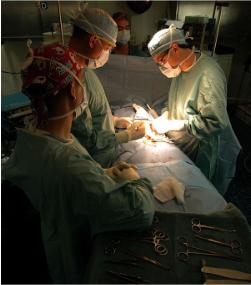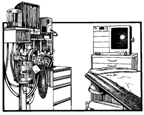|
ANESTHESIA
ANESTHESIA - Partial or complete loss of sensation with or with
out loss of consciousness as result of disease, injury, or
administration of an anesthetic agent, usually by injection or
inhalation.
HISTORY OF ANESTHESIA
PRIMITIVE TECHNIQUES
Club
Strangulation
Alcohol
Mesmerism
Plants
HISTORY OF ANESTHESIA
INHALATION AGENTS
Nitrous Oxide
1799 Davy
1824 Hickman
1844 Wells
Ether
1842 Long
1847 Snow
|
 HISTORY OF ANESTHESIA
LOCAL/REGIONAL
1836 needle trochar
1844 hollow needle
1851 syringe
1884 Koller opthalmic
anesthesia
1885 Hallstead/Hall
local/regional blocks
1898 Bier spinal
ANESTHESIA OVERVIEW
STAGES OF GENERAL ANESTHESIA
STAGE 1 (Amnesia): From induction of anesthesia to loss of
conciousness (loss of eyelid reflex). Pain perception threshold is
not lowered.
ANESTHESIA OVERVIEW
STAGES OF GENERAL ANESTHESIA
STAGE 2 (Delirium/Excitement): Characterized by uninhibited
excitation. Pupils are dilated and eyes divergent. Agitation,
delirium, irregular respiration, and breatholding are commonly seen.
Potentially dangerous responses can occur during this stage
including vomiting, laryngospasm, HTN, tachycardia, and uncontrolled
movement.
ANESTHESIA OVERVIEW
STAGES OF GENERAL ANESTHESIA
STAGE 3 (Surgical Anesthesia): Central gaze,constricted pupils,
and regular respirations. Target depth of anesthesia is sufficient
when painful stimulation does not elicit somatic reflexes or
deleterious autonomic reflexes.
ANESTHESIA OVERVIEW
STAGES OF GENERAL ANESTHESIA
STAGE 3
Plane 1 From the return of regular respirations to the cessation
of REM.
ANESTHESIA OVERVIEW
STAGES OF GENERAL ANESTHESIA
STAGE 3
Plane 2 The Surgical Plane
From the cessation of REM to the onset of paresis of the
intercostal muscles.
ANESTHESIA OVERVIEW
STAGES OF GENERAL ANESTHESIA
STAGE 3
Plane 3 From the onset to the complete paralysis of the
intercostal muscles.
ANESTHESIA OVERVIEW
STAGES OF GENERAL ANESTHESIA
STAGE 3
Plane 4
From the paralysis of the intercostal of this plane the
patient will be apneic. muscles to the paralysis of the diaphragm - at the
end
ANESTHESIA OVERVIEW
STAGES OF GENERAL ANESTHESIA
STAGE 4 (Impending Death/Overdose): Onset of apnea,
dilated and nonreactive pupils, and hypotension to complete circulatory
failure.
ANESTHESIA OVERVIEW
COMPONENTS OF GENERAL ANESTHESIA
1. Unconsciousness
(Hypnosis)
2. Analgesia (Areflexia)
3. Muscle
relaxation
Continue
to the PowerPoint Lecture...
From
SFC Hill
Joint Special Operations Medical Training Center
In
Operational
Medicine 2001
Bureau of Medicine
and Surgery
Department of the
Navy
|


